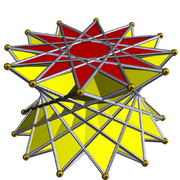Dodecagram
This article needs additional citations for verification. (August 2012) |
| Regular dodecagram | |
|---|---|
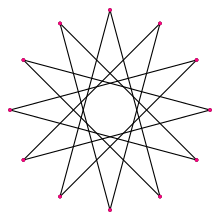 A regular dodecagram | |
| Type | Regular star polygon |
| Edges and vertices | 12 |
| Schläfli symbol | {12/5} t{6/5} |
| Coxeter–Dynkin diagrams | |
| Symmetry group | Dihedral (D12) |
| Internal angle (degrees) | 30° |
| Properties | star, cyclic, equilateral, isogonal, isotoxal |
| Star polygons |
|---|
|
|
A dodecagram is a star polygon or compound with 12 vertices. There is one regular dodecagram polygon, {12/5}, having a turning number of 5. There are also 4 regular compounds {12/2}, {12/3} {12/4}, and {12/6}
The name "dodecagram" combines the numeral prefix dodeca- with the Greek suffix -gram. The -gram suffix derives from γραμμῆς (grammēs), which denotes a line.[1]
Regular dodecagram[]
There is one regular form: {12/5}, containing 12 vertices, with a turning number of 5. A regular dodecagram has the same vertex arrangement as a regular dodecagon, which may be regarded as {12/1}.
Dodecagrams as regular compounds[]
There are four regular dodecagram star figures: {12/2}=2{6}, {12/3}=3{4}, {12/4}=4{3}, and {12/6}=6{2}. The first is a compound of two hexagons, the second is a compound of three squares, the third is a compound of four triangles, and the fourth is a compound of six straight-sided digons. The last two can be considered compounds of two compound hexagrams and the last as three compound tetragrams.

2{6}

3{4}
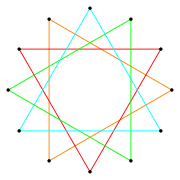
4{3}
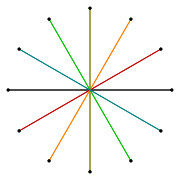
6{2}
Dodecagrams as isotoxal figures[]
An isotoxal polygon has two vertices and one edge type within its symmetry class. There are 5 isotoxal dodecagram star with a degree of freedom of angles, which alternates vertices at two radii, one simple, 3 compounds, and 1 unicursal star.
| Type | Simple | Compounds | Star | ||
|---|---|---|---|---|---|
| Density | 1 | 2 | 3 | 4 | 5 |
| Image |  {(6)α} |
 2{3α} |
 3{2α} |
 2{(3/2)α} |
 {(6/5)α} |
Dodecagrams as isogonal figures[]
A regular dodecagram can be seen as a quasitruncated hexagon, t{6/5}={12/5}. Other isogonal (vertex-transitive) variations with equally spaced vertices can be constructed with two edge lengths.
 t{6} |
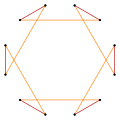
|
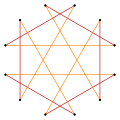
|
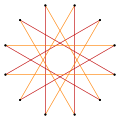 t{6/5}={12/5} |
Complete graph[]
Superimposing all the dodecagons and dodecagrams on each other – including the degenerate compound of six digons (line segments), {12/6} – produces the complete graph K12.
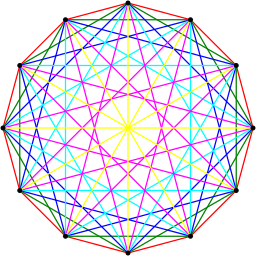
|
black: the twelve corner points (nodes) red: {12} regular dodecagon |
Regular dodecagrams in polyhedra[]
Dodecagrams can also be incorporated into uniform polyhedra. Below are the three prismatic uniform polyhedra containing regular dodecagrams (there are no other dodecagram-containing uniform polyhedra).
Dodecagrams can also be incorporated into star tessellations of the Euclidean plane.
Dodecagram Symbolism[]

Dodecagrams or twelve-pointed stars have been used as symbols for the following:
- the twelve tribes of Israel, in Judaism
- the twelve disciples, in Christianity
- the twelve olympians, in Hellenic Polytheism
- the twelve signs of the zodiac
- the International Order of Twelve Knights and Daughters of Tabor, an African-American fraternal group
- the fictional secret society Manus Sancti, in the Knights of Manus Sancti series by Bryn Donovan
- The twelve tribes of Nauru on the national flag.
See also[]
References[]
- Weisstein, Eric W. "Dodecagram". MathWorld.
- Grünbaum, B. and G.C. Shephard; Tilings and Patterns, New York: W. H. Freeman & Co., (1987), ISBN 0-7167-1193-1.
- Grünbaum, B.; Polyhedra with Hollow Faces, Proc of NATO-ASI Conference on Polytopes ... etc. (Toronto 1993), ed T. Bisztriczky et al., Kluwer Academic (1994) pp. 43–70.
- John H. Conway, Heidi Burgiel, Chaim Goodman-Strass, The Symmetries of Things 2008, ISBN 978-1-56881-220-5 (Chapter 26. pp. 404: Regular star-polytopes Dimension 2)
- Star polygons






